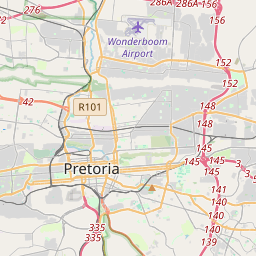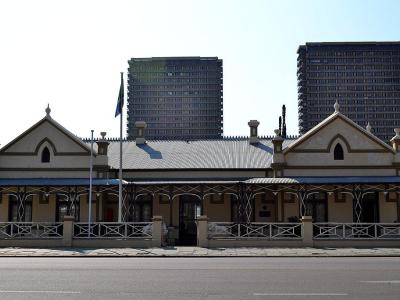
Pretoria Introduction Walking Tour (Self Guided), Pretoria
Pretoria, one of South Africa's three capitals (the other two being: Cape Town – legislative, and Bloemfontein – judicial), is commonly regarded as “Jacaranda City” for the abundance of jacaranda trees. The history of Pretoria is rich in events closely associated with the history of the South African Republic, some of which are reflected in a number of local attractions, such as the Union Buildings and the Voortrekker Monument, commemorating early Afrikaans settlers from the Cape Colony. To explore these and other main attractions of Pretoria, follow this orientation walk.
How it works: Download the app "GPSmyCity: Walks in 1K+ Cities" from Apple App Store or Google Play Store to your mobile phone or tablet. The app turns your mobile device into a personal tour guide and its built-in GPS navigation functions guide you from one tour stop to next. The app works offline, so no data plan is needed when traveling abroad.
Pretoria Introduction Walking Tour Map






Guide Name: Pretoria Introduction Walking Tour
Guide Location: South Africa » Pretoria (See other walking tours in Pretoria)
Guide Type: Self-guided Walking Tour (Sightseeing)
# of Attractions: 9
Tour Duration: 3 Hour(s)
Travel Distance: 5.8 Km or 3.6 Miles
Author: julia
Sight(s) Featured in This Guide:
Guide Location: South Africa » Pretoria (See other walking tours in Pretoria)
Guide Type: Self-guided Walking Tour (Sightseeing)
# of Attractions: 9
Tour Duration: 3 Hour(s)
Travel Distance: 5.8 Km or 3.6 Miles
Author: julia
Sight(s) Featured in This Guide:
- Church Square
- Kruger House
- National Cultural History Museum
- Chief Tshwane Statue
- Ditsong National Museum of Natural History
- Melrose House
- Burgers Park
- South African State Theatre
- Union Buildings
1) Church Square (must see)
Church Square is the historic center of the city of Pretoria. It's most prominent feature is the statue of the Boer leader and president of the South African Republic, Paul Kruger. Statues of four anonymous Boer citizen-soldiers surround Kruger's on a lower level of the plinth. Several historically and architecturally significant buildings surround the square: the Palace of Justice, the Old Capitol Theater, the Tudor Chambers, the Ou Raadsaal (Old Council Chamber) and the General Post Office, which was designed by John Cleland.
Sight description based on Wikipedia.
2) Kruger House (must see)
Kruger House is the historic Pretoria residence of the President of the South African Republic, Paul Kruger (1825-1904). It was built in 1884 by architect Tom Claridge and builder Charles Clark. Milk was used instead of water for mixing the cement from which the house was constructed, as the cement available was of poor quality. The house was one of the first in Pretoria to be lit by electricity. The house contains either the original furnishings or items from the same historical period, some of the many gifts that were presented to Kruger, and other memorabilia. An interesting feature of the house is the pair of stone lions on the veranda that were presented to President Kruger as a birthday gift in 1896 by the mining magnate Barney Barnato. The Kruger House is now a house museum that tries to recreate the ambience of the period in which Kruger lived.
Sight description based on Wikipedia.
3) National Cultural History Museum (must see)
The National Cultural History Museum, also known as the "African Window," is located in the Old Mint. It is called the most dynamic museum in the city because of its constantly changing exhibitions. The museum houses a collection of at least five million objects related to the history and culture of South Africa, from the stone age to the present, and from both the indigenous peoples and European colonists.
4) Chief Tshwane Statue
The statue of Chief Tshwane is a 3.6 meter tall bronze monument, created by Angus Taylor and situated in front of Pretoria's City Hall. It is claimed by some that Tshwane led a group of Africans who first settled on the site of the city, before the coming of European settlers, but others question whether such a person ever existed. The larger metropolitan area of which Pretoria is a part has been named Tshwane; it has been proposed to bestow the name on the city itself, but that proposal is a subject of controversy.
5) Ditsong National Museum of Natural History (must see)
The Ditsong National Museum of Natural History, formerly Transvaal Museum, is a natural history museum situated in Pretoria. It was founded as the Staatsmuseum (Afrikaans for "State Museum") of the ZAR on the 1 December 1892, and J. W. B. Gunning was appointed as first director. The museum was located for the first two years in the Ou Raadsaal parliament building.
The Transvaal Museum curates large collections of Plio-Pleistocene fossils, as well as late Permian therapsids. In addition the museum holds very large collections of mammals, birds, reptiles, and invertebrates. The museum is located on Paul Kruger Street, between Visagie and Minnaar Streets, opposite the Pretoria City Hall.
The Transvaal Museum curates large collections of Plio-Pleistocene fossils, as well as late Permian therapsids. In addition the museum holds very large collections of mammals, birds, reptiles, and invertebrates. The museum is located on Paul Kruger Street, between Visagie and Minnaar Streets, opposite the Pretoria City Hall.
Sight description based on Wikipedia.
6) Melrose House (must see)
Melrose House is a stately Victorian mansion that was built in 1886 by the prosperous Pretoria businessman George Jesse Heys. It was named after the famous Melrose Abbey in Scotland. Melrose House gained fame during the Second Boer War (1899–1902), when Lord Roberts requisitioned it as the headquarters for the British forces after Pretoria was captured in June 1900.
Today, this elegant house is a museum that represents the transition from Victorian to Edwardian architectural styles and interiors. The interior is characterized by colorful stained glass windows, paintings by English artists, carpets in rich colors, ornate ceilings and fireplaces, and valuable porcelain ornaments. The majority of these items were the property of the Heys family.
Today, this elegant house is a museum that represents the transition from Victorian to Edwardian architectural styles and interiors. The interior is characterized by colorful stained glass windows, paintings by English artists, carpets in rich colors, ornate ceilings and fireplaces, and valuable porcelain ornaments. The majority of these items were the property of the Heys family.
Sight description based on Wikipedia.
7) Burgers Park
Burgers Park was completed in 1892 and is the oldest park in Pretoria. It was used as a camping area by Voortrekkers (early Dutch settlers) before the city was established. Among the attractions оf this 9.8 acre Victorian-style park are a large fish pond with fountains, a tea garden, a florarium, and a cactus greenhouse. Also there are many trees planted in commemoration of important events.
8) South African State Theatre
South African State Theatre is not just a theatre. It is a complex of venues capable of hosting all kinds of artistic and commercial events, from opera, ballet, cabaret, film festivals, and children's theatre to weddings, parties, and product launches. The theatre plays a leading role in developing and training local performing arts groups.
9) Union Buildings (must see)
The Union Buildings form the official seat of the South African government and also house the offices of the President of South Africa. The imposing buildings are located atop Meintjieskop at the Northern end of Arcadia, close to historic Church Square and the Voortrekker Monument. The large gardens of the Buildings are nestled between Government Avenue, Vermeulen Street East, Church Street, the R104, and Blackwood Street. Fairview Avenue is a closed road where only officials can enter to the Union Buildings. Though not in the center of Pretoria the Union Buildings occupy the highest point of Pretoria, and constitute a South African National monument.
The Buildings are one of the centres of political life in South Africa; "The Buildings" and "Arcadia" have become metonyms for the South African Government. It has become an iconic landmark of Pretoria and South Africa in general, and is one of the most popular tourist attractions in the city and an emblem of democracy.
The Union Buildings, built from light sandstone, were designed by the architect Sir Herbert Baker in the English monumental style and are 285 m long. They have a semi-circular shape, with the two wings at the sides, this serves to represent the union of a formerly divided people. The clock chimes are identical to those of Big Ben in London.
The Buildings are one of the centres of political life in South Africa; "The Buildings" and "Arcadia" have become metonyms for the South African Government. It has become an iconic landmark of Pretoria and South Africa in general, and is one of the most popular tourist attractions in the city and an emblem of democracy.
The Union Buildings, built from light sandstone, were designed by the architect Sir Herbert Baker in the English monumental style and are 285 m long. They have a semi-circular shape, with the two wings at the sides, this serves to represent the union of a formerly divided people. The clock chimes are identical to those of Big Ben in London.
Sight description based on Wikipedia.
Walking Tours in Pretoria, South Africa
Create Your Own Walk in Pretoria
Creating your own self-guided walk in Pretoria is easy and fun. Choose the city attractions that you want to see and a walk route map will be created just for you. You can even set your hotel as the start point of the walk.
Pretoria Landmarks Walking Tour
Pretoria is called South Africa in miniature. The variety of its landmarks represent the variety of the whole country. The following attractions are the most representative in this marvelous city. Take this tour to view the parks, monuments, government buildings, and other landmarks of Pretoria.
Tour Duration: 3 Hour(s)
Travel Distance: 7.4 Km or 4.6 Miles
Tour Duration: 3 Hour(s)
Travel Distance: 7.4 Km or 4.6 Miles
The Most Popular Cities
/ view all










